October 16, 2009
Air Date: October 16, 2009
FULL SHOW
SEGMENTS
Two Parties, One Climate
View the page for this story
Republican Lindsey Graham of South Carolina and Democrat John Kerry of Massachusetts reached across the aisle to outline a possible bipartisan path for U.S. Senate approval of climate change legislation. David Jenkins of Republicans for Environmental Protection tells host Jeff Young it’s a game changer. (04:00)
Murkowski on Climate Action
View the page for this story
Senator Lisa Murkowski is commending her colleagues, Republican Lindsey Graham and Democrat John Kerry, for offering a bipartisan approach to climate change. The Alaskan senator tells host Jeff Young she supports many of the ideas outlined in their recent New York Times column, including the need to move forward with nuclear power, offshore drilling and clean coal, but she’s still not ready to commit to a cap and trade system for cutting emissions. (03:15)
Wet and Wild
View the page for this story
In the tiny island nation of the Maldives the threats from climate change are visible. Averaging about two meters above sea level, the Maldives is bracing itself for rising seas. So the president has come up with a splashy stunt: holding his next cabinet meeting underwater. Host Jeff Young talks with Mohamed Aslam, the Minister of the Environment about this gathering. (04:35)
Ford’s Focus on Electric Cars
View the page for this story
Host Jeff Young gets behind the wheel of the all-electric Ford Focus, with Ford’s head of electric cars riding shotgun. We’ll hear what this iconic but struggling automaker has planned for electric drive vehicles, and whether the billions U.S. taxpayers are pumping into cleaner cars is paying off. (05:50)
Keeping Current on Electric Cars
View the page for this story
American taxpayers have pumped more than two billion dollars into electric drive vehicles. What are U.S. car companies doing? Host Jeff Young talks with car rider and writer Jim Motavalli about what’s down the road for electric vehicles. (05:45)
Vehicle Visionary
View the page for this story
From hybrids to electric vehicles, there has been a lot of innovation in the car industry lately. But according to Robin Chase, the founder of the car-sharing business, Zipcar, we need to alter our entire driving experience. Chase sat down with host Jeff Young and explained how sustainable transportation has more to do with the ways that we use the car than the type of car that we drive. (06:15)
Small Science
/ Naomi FowlerView the page for this story
Researchers come from all over the world to a one-of-a-kind facility called the ISIS Center in the United Kingdom. There they use special equipment, such as super microscopes and proton accelerators, to study materials at the atomic level. Deutsche Welle Radio's Naomi Fowler gets a tour by a scientist who looks at the amazing properties of spider silk. (06:45)
Tiny Architects
View the page for this story
They are just the size of pin heads but termites are giving us big ideas about efficient green buildings. Living on Earth’s Steve Curwood spoke with J. Scott Turner, who teaches biology at the State University of New York in Syracuse, about what we can learn from these tiny builders. (06:30)

Branching into New Sounds
View the page for this story
Diego Stocco, a sound designer in Burbank, California discovers the wealth of sounds he can produce by playing a tree. (03:45)
Show Credits and Funders
Show Transcript
HOSTS: Jeff Young
GUESTS: David Jenkins, Lisa Murkowski, Mohamed Aslam, Nancy Gioia, Jim Motavalli, Robin Chase, Jay Scott Turner
REPORTERS: Naomi Fowler, Ike Sriskanderajah
[THEME]
YOUNG: From Public Radio International - this is Living on Earth.
[THEME]
YOUNG: I'm Jeff Young. A possibly bipartisan path to action on climate change. One Republican Senator reaches across the aisle.
JENKINS: Senator Graham to his credit has stepped forward and said, look this is a problem and we need to work on it together and I’m willing to step forward and try to and try to craft something we can pass. I think it’s a potential game-changer in the effort to pass climate legislation this year.
YOUNG: We take the global warming temperature of the Grand Old Party. Also, a visit with a composer who discovered a new instrument growing in his own backyard.
STOCCO: To create the rhythm I used a big branch by hitting against the cortex and leaves, so basically it’s like this:
[SHAKING BRANCHES; TAPPING SOUND ON TREE]
YOUNG: Tree music – and what termites have to teach us about green building. Those stories and much more this week on Living on Earth, so stick around.
ANNOUNCER: Support for Living on Earth comes from the National Science Foundation and Stonyfield Farm.
[THEME]
Two Parties, One Climate

David Jenkins is the Government Affairs Director for Republicans for Environmental Protection. (Courtesy of Republicans for Environmental Protection)
YOUNG: From the Jennifer and Ted Stanley Studios in Somerville, Massachusetts - this is Living on Earth - I’m Jeff Young. Beltway pundits had declared it politically dead on arrival. But a climate change bill is starting to show signs of life in the US Senate. Committee hearings begin later this month on a mandatory cap on greenhouse gas emissions.
And we just saw the first indications of a possible bipartisan path to Senate approval. South Carolina Republican Senator Lindsay Graham co-authored an opinion piece with the bill’s lead sponsor, Massachusetts Democrat John Kerry. It was titled, “‘Yes We Can’ pass climate change legislation.” David Jenkins has some analysis for us. Jenkins works the halls of Congress for the group Republicans for Environmental Protection. He says Senators Graham and Kerry caused quite a stir on Capitol Hill.
JENKINS: I think it’s a potential game-changer in the effort to pass climate legislation this year. For so long we’ve seen a lot of partisanship very evident when we get into some of these major issues, and Senator Graham to his credit has stepped forward and said, look this is a problem and we need to work on it together and I’m willing to step forward and try to offer constructive input into the process and try to craft something that we can pass.
YOUNG: And what are the main elements that they outline there that might make some bipartisan agreement possible?
JENKINS: They’re talking about basically sort of merging the ideas of addressing climate change with the energy security aspect of it. And from the Republican side, you know, nuclear is a very important part of that equation. Senator Graham mentioned specifically some offshore drilling components possibly as well.
But more importantly than the specifics, what we want to avoid is people just laying out markers and saying, well if it doesn’t have this, we’re gonna bolt. But what it signals is the beginning of a constructive dialog on climate, which we really didn’t have on the House side.

David Jenkins is the Government Affairs Director for Republicans for Environmental Protection. (Courtesy of Republicans for Environmental Protection)
YOUNG: All right, let’s count some votes here. How many Republicans in the Senate do you think might be swayed by the kind of bipartisan outline agreement that Senators Kerry and Graham are talking about here?
JENKINS: I don’t anyone is going to jump to the forefront right now and say, I’m in, but in terms of those that could very easily be there at the end, I think you’re talking six or seven Republicans at least. You gotta look at Senator Murkowski in Alaska; Senator Lugar in Indiana; Senator McCain, of course a very close friend of Senator Graham; Senator Snow and Collins; and there might be some others like Judd Gregg of New Hampshire, or Johnny Isakson of Georgia.
YOUNG: And tell me about Senator Lindsey Graham, do you know what it is that apparently changed his mind on this issue because he voted against climate change bills, even those brought to the floor by his good friend, Senator McCain, he voted against them. And now he’s indicating he thinks this is an important issue that needs to be addressed – what happened there?
JENKINS: Actually, Senator Graham has been saying this is an important issue that needs to be addressed for quite some time since he went to Alaska with Senator McCain and observed some of the impacts of climate change. I think what you see with Senator Graham is he’s not really willing to step up and expend political capital on lost causes; the previous times that climate legislation has come before the Senate, you had the Bush administration in the White House, you had much shakier numbers when from a standpoint of Senators willing to support this, so at that time he was convinced it wasn’t going to pass, or if it did pass it wasn’t going to be enacted into law; and there was really no reason for him to step up and be forward at that time.
But now, what I think he sees is true opportunity to pass something, and I think the fact that he’s willing to step forward now should really give a lot of confidence to those that want to pass climate legislation because he’s seeing something in the numbers that he believes he can make a difference here, and when he sees the opportunity to make a difference, he steps forward, and that’s what we’re seeing right now.
Related link:
U.S. Senator Lisa Murkowski, (R-Alaska)
Murkowski on Climate Action
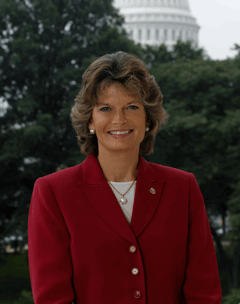
U.S. Senator Lisa Murkowski of Alaska
YOUNG: David Jenkins of Republicans for Environmental Protection. He put Senator Lisa Murkowski’s name at the top of that list of Republicans who might warm to a bipartisan approach to climate change. She’s the top Republican on the Senate’s Energy committee and a major ally of the oil industry – her state, Alaska, is a major oil producer. But Senator Murkowski also recognizes that Alaska’s on the front lines of global warming—already seeing melting permafrost, sea ice loss and extreme coastal erosion. We called her up to get her thoughts. Senator Murkowski, thanks for joining us.
MURKOWSKI: Good to be with you, Jeff.
YOUNG: Now, your colleagues, Senators Graham and Kerry appear to have reached an agreement, in principle anyway, on a possible bipartisan approach to climate change legislation. What do you make of the ideas that they’ve laid out?
MURKOWSKI: Well, I’ll tell you that I’m encouraged that you can have a Democratic Senator from a state like Massachusetts join together with a Republican Senator from the state of South Carolina to sit down and talk honestly and intellectually about how we can advance climate change legislation. I think it’s good. I’m going to be meeting with Senator Graham to talk about more of the specifics of what he is considering, but the proposal that was outlined in the opinion piece I think holds out some promise.
YOUNG: In general, and I understand that the devil is always in the details with these things, but in general, is this the sort of thing you think you might support someday?
MURKOWSKI: Well, again we need to recognize that there has been no legislation; there has been no draft put out there. I like the reality that they present that in order to meaningfully reduce our emissions we must have enhanced nuclear in this country. I think there’s also a recognition that increased domestic production of our resources, whether they be coal or whether they be oil or gas, I think that there is a recognition that this goes toward our energy security and what we need to do is figure out those technologies that will allow them to be more clean-burning to reduce our carbon footprint.

U.S. Senator Lisa Murkowski of Alaska
I would really want to understand how their proposed cap and trade piece works. I have some real apprehension about the opportunity for manipulation under cap and trade proposal. I have some real concerns about how the offsets would work. I have real concerns about distribution of allowances. So, those types of issues would have to be made far more clear to me before I would venture a guess as to where I might go.
YOUNG: So, it sounds to me like you’re warming up to the idea. Cautiously optimistic about being able to support something.
MURKOWSKI: I am watching carefully with the proposals that have been generated thus far, but I am also optimistic that at this point in the process you have people of goodwill and good intentions that continue to talk to try to deal with one of the greatest challenges that our nation faces.
YOUNG: Senator Lisa Murkowski, Republican from Alaska, thanks very much for your time.
MURKOWSKI: Thank you, I appreciate it.
YOUNG: For more of our interview with Senator Murkowski and more analysis of the progress of that Climate Change Bill, go to our website, LOE dot org.
Related links:
- Listen to LOE Full Interview with Alaska Senator Lisa Murkowski
- NY Times Op-Ed by Sen. Graham and Sen. Kerry
- Republicans for Environmental Protection
[MUSIC: Alice Russell “All Alone (Captain Planet Remix)” from ‘Pot Of Gold Remixes Vol. 2’ (Six Degrees Records - 2009)]
Wet and Wild
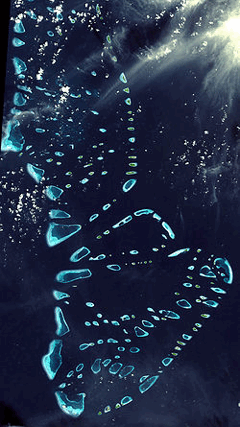
Satellite photo of the Maldives, a group of atolls (Courtesy of Wikipedia)
YOUNG: Global warming is the stuff of dry political debate in Washington – but for the Maldive islands it’s as unavoidable as the rising seas that surround them. This nation of low-lying coral atolls sits about 500 miles southwest of the southern tip of India. Its government is deeply concerned about climate change. Mohamed Aslam is the Minister of the Environment for the Maldives – and – Minister, I hear your government’s upcoming cabinet meeting about climate change will make quite a splash.
ASLAM: Yes, I think it’s the first time any Cabinet is going to have a meeting underwater, I guess.
YOUNG: How do you carry out a meeting underwater?

Mr. Mohamed Aslam, Minister of Housing, Transport and Environment
ASLAM: Of course, we don’t have gills. We haven’t evolved to have gills yet, so we have to have breathing equipment with scuba gear and then we will talk to each other by sign language, and we will have a statement sign underwater.
YOUNG: Tell us a bit about the Maldives – how high does your land rest above sea level?
ASLAM: In terms of its height above mean sea level, it doesn’t rise anything above two meters above sea level, so if the sea level rises as predicted in the next hundred years to 50 centimeter rise that means much of our land would be underwater, and before going underwater a lot of things are going to happen. There would be salinization of the fresh groundwater we have on the islands, which in turn, would kill much of the vegetation, at least anything that would be edible. So, going with the waves would be the doomsday scenario, but before the doomsday, there will be a lot of things that will make this place uninhabitable.

Satellite photo of the Maldives, a group of atolls (Photo: Wikipedia)
YOUNG: What’s the mood among people in the Maldives? What do you hear from ordinary folks around the country?
ASLAM: Some of the people understand that this is going to happen. Some maybe don’t understand that it is going to happen. It’s hard for some people to believe that children may not be living on the land where their forefathers lived and where they are living. This issue of climate change seems to be something similar to people who smoke, where the smokers know that they are going to die of smoking, but they still continue to smoke.
So, it’s something similar to that sort of thing, I think. But the majority of the Maldivians do understand it is going to happen. There is one other thing we want to send out to the world - we don’t want to leave this place, this is where we were born, this is where our forefathers were born and we want our children to live here and this is home for us. We don’t want to leave this place.
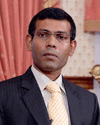
Mr. Mohamed Nasheed, President of the Republic of Maldives
YOUNG: I recall hearing the Maldives president, Mr. Nasheed, give a very passionate speech at the recent climate summit at the United Nations. However, I was wondering, what is the nation of the Maldives doing itself to bring down or limit greenhouse gas emissions?
ASLAM: We don’t emit anything significant, there’s 350,000 people, there isn’t anything industrial that emits anything much. Nonetheless, there is a policy that we have announced, the president has announced, trying to go carbon neutral in ten years.
Now, our point of going carbon neutral is not that we believe that us going carbon neutral is going to save the world. But we want to send out again a message to the world, look we know we are in the front line of this battle, we want to do everything in our capacity to lead by example.
But what I would like to tell the global community is that people should look at us as the mirror to see their own future. We might be the first people who will be facing this, but we won’t be the last. If this happens to us today, it’s going to happen to you tomorrow. And people should not be hypocritical about this, people should meet words with actions, and it’s not really helping us, it’s really helping yourself; it’s saving the world.
YOUNG: Maldives Environment Minister, Mohamed Aslam, telling us about the government’s underwater cabinet meeting. Thank you very much, sir.
ASLAM: Thanks very much, I hope the message goes out loud and clear.
Related link:
To learn more about the President’s plan
[MUSIC: Tom Verlaine “Saucer Crash” from ‘Warm And Cool’ (Thrill Records - 2006)]
YOUNG: Well, just ahead, we get behind the wheel of motor city’s hot new electric ride. Keep listening to Living on Earth!
Ford’s Focus on Electric Cars
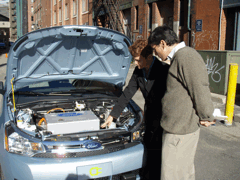
Nancy Gioia shows Jeff Young the engine of the Ford Focus.
YOUNG: It’s Living on Earth, I’m Jeff Young. The Obama administration is making a big money bet on cleaner cars. The Department of Energy has loaned eight and a half billion dollars so far to help automakers retool for fuel efficiency and that’s on top of the bailout money for Chrysler and GM. About two-point four billion went specifically toward electric vehicle research. So, just how are US carmakers doing in the electric car effort? Ford has a few electric and plug-in hybrid models in the works. And Nancy Gioia who directs Ford’s Global Electrification offered us a test drive. She met me with the keys for what looked like an ordinary Ford Focus.
GIOIA: That’s our ride - it’s a battery electric Focus.

The Ford Focus battery.
YOUNG: Tell me about it.
GIOIA: Well, it goes up to a hundred mile range is the target. It’s fully a battery-electric vehicle, so there’s no engine, no emission systems, no fuel tank, all of those things. Instead, what we have is a high-voltage, lithium-ion battery that then drives electric motors that drive the wheels.
YOUNG: So, are we charged up?
GIOIA: We’re charged up.
YOUNG: Charged up, ready to roll?
GIOIA: Ready to roll, let’s go!
YOUNG: Let’s take it for a spin, alright.
[OPENING AND CLOSING OF DOORS]
YOUNG: All righty, so now it’s going to go “vroom vroom” when I start it up, right?
GIOIA: It’s not going to say or do anything for ya. There you go.

Nancy Gioia shows Jeff Young the engine of the Ford Focus.
YOUNG: Has it started?
GIOIA: You’re good to go.
[YOUNG LAUGHS]
GIOIA: So just go ahead, press into it.
YOUNG: All righty.
GIOIA: One of the myths is electric vehicles are slow or not very responsive.
YOUNG: Like overgrown golf cart or something like that.
GIOIA: Exactly. But let me tell ya, battery-electrics are peppy, lots of torque, lots of fun-to-drive capability.
YOUNG: Peppy, eh? I’m going to test the acceleration.
[SOUND OF SMOOTH HUMMING INCREASING]
YOUNG: Wheeeee! Yeah, I felt that. It handles really well. It’s tight.
GIOIA: You know, what we tried to do is make it respond just like a regular Focus does. So, the ride, the handling, the steering.
YOUNG: So, what are the big barriers from the consumer’s point-of-view, do you think? Is it – it’s the range, the charging, that sort of thing?
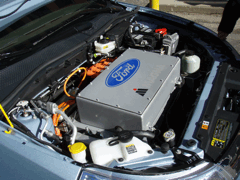
The Ford Focus Engine.
GIOIA: Absolutely, range anxiety from a customer standpoint for battery-electrics, probably top of mine. Affordability – these will be more expensive vehicles. And many customers, over the life cycle, the fuel cost versus the upfront vehicle cost, many of our customers separate those in their mind. When they buy a car, they don’t also think about the fuel cost over the lifetime of that vehicle or their use. When you buy a battery-electric, we need to make sure people understand if you think about those in conjunction this could actually be a great payback for you.
[CAR DOORS OPENING]
GIOIA: Let’s hop out!
[CAR DOORS CLOSING]
GIOIA: Any other questions on a battery-electric?
YOUNG: Uh, well, I get to keep these right?
[JINGLING KEYS]
GIOIA: No, we’ll take the keys back. [Laughs]
YOUNG: Oh, okay. Can we take a look at what makes it work?
GIOIA: Absolutely, sure. Under the hood and under the body.
[CAR HOOD POPPING OPEN]
GIOIA: There you go. Okay, so what you see here is obviously the engine’s missing. [Laughs] So, it has a big difference. Underneath is motors that drive the wheels. And we have electric air conditioning, you know, we have things still like our radiator fuels and all the other things that have to run, but those are then run by electric elements instead of hydraulic.
YOUNG: So, if people buy this electric Focus, are they going to have places where they can plug in, and what’s Ford doing along those lines?
GIOIA: Yeah, what we’re doing is we’re working with our utility partners very closely to understand how to make sure our vehicle is compatible with the utility grid. We’re also working with cities, laying out maps for what kind of infrastructure is needed – what’s customer behavior like? So that as city planners and things like this jump, in they can start to include this.
YOUNG: So, you’re going to be making 5,000 or so of these in the initial go-around. That doesn’t sound like that many cars, given the number of cars that Ford makes. How big a part of the picture will electric vehicles be for Ford?
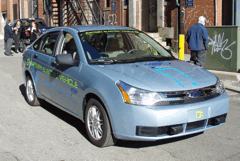
The new Ford Focus.
GIOIA: We think by 2020 we’ll have to have ten to 25 percent of our new fleet electrified. Electrification’s a core part of our fleet going forward and our technology going forward. We think it’s essential.
YOUNG: The Asian automakers, in general, seem so far out ahead on this. Everyone knows about the Prius, I see a lot of Honda hybrids on the road. Can Ford and the other US automakers catch up?
GIOIA: Well, I think – just one fact: Ford is the second largest producer of full hybrids in the world. We have absolutely encouraged domestic battery manufacture, because having that knowledge and ability to make energy storage here in this country and every region around the world is really important. It’s energy security, it helps on climate change, and it helps unemployment security.
YOUNG: Ford has such a history, an iconic American company. Where does what you’re doing with electric vehicles, you think, fit in the legacy of Ford as a motor company, as an innovator?
GIOIA: Well, it absolutely fits right in, as a matter of fact, back in the early 1900’s, 1911 to 1917 to 1930 even, electric vehicles were a big part of America’s auto fleet – 30 percent were electrified. So, as we went forward, it’s always been about the battery. The great news is the technology is finally there and we’re putting the vehicles on the road that can help customers enjoy their drive and use less fuel.
YOUNG: What do you think Henry Ford would think if he were here looking at these?
GIOIA: Oh, I think he’d love it. He would say, why did it take so long?
[LAUGHING]
YOUNG: Well, Nancy Gioia, very nice to meet you.
GIOIA: Hey, Jeff, I really appreciate it, thanks for your time today.
[FADING STREET AND CAR NOISED]
Related links:
- Click here for Ford’s Top Ten Eco Driving Tips
- Ford’s Smart Gauge Guide
Keeping Current on Electric Cars
YOUNG: Nancy Gioia says the electric Focus is coming in 2011— no word yet on the price tag. GM’s main electric offering, the Chevy Volt plug-in hybrid, rolls out late next year. Environment writer Jim Motavalli calls the field embryonic now, but close to explosive growth. He’s the author of the book “Forward Drive,” and writes about electric cars for the New York Times. I asked Jim who has the inside track on electric cars.
MOTAVALLI: I think Ford is actually at the forefront of the three, big American automakers. I think they actually have a good overall strategy. General Motors could be said to be putting all of its efforts into the Volt, and I think time will tell whether that’s a good strategy or not. Because of its economic woes, Chrysler has announced that it’s going to be building electric-drive vehicles, but I think they’ve been able to spend very little on developing those. I think Ford’s plans in this space are very conservative. Like, they would say that they’re only going to do like 5, 000 to 10,000 of the Focus-based electric cars, worldwide, in 2011 – that’s a very small number. It’s certainly not going to make a dent in the worldwide auto industry, but they’re not sure. They don’t think there’s a lot of early adopters out there.
YOUNG: So, where do the US companies then compare to what companies based in other countries are doing?
MOTAVALLI: I would say probably the smartest overall strategy for vehicle electrification is coming from Nissan, a Japanese company, and what’s smart about their approach is they’ve also got into the charging business. The Renoit-Nissan alliance has built strategic alliances around the world to set up charging stations.
YOUNG: What about Chinese automakers?
MOTAVALLI: I think Chinese automakers are very well poised, because the Chinese companies, in many cases, are vertically integrated and also own battery companies. The most prominent player in this space is BYD, which is a Chinese company. I think the name translates to Build Your Dreams and Warren Buffet is a ten percent owner in this company now, and probably would buy more if they let him. And they are one of China’s biggest battery makers. They make batteries for all kinds of portable electronic devices. But they have also got to be a fairly large automaker in China - they introduced the world’s first plug-in hybrid car on the Chinese market and they’re planning to bring a battery car into the US that would be competitive with vehicles like the Ford battery-electric and the Nissan Leaf.
YOUNG: So, you’ve been visiting a lot of automakers, test driving a lot of vehicles, going to companies both big and small. Who do you think has the juice here? And by juice, I mean the kind of innovative spirit – who’s really bring the new ideas to the table here?
MOTAVALLI: Well, I think the most creative ideas I see generally tend to be out of a startups. Tesla’s only built 700 cars. Fisker has not yet actually put out its Carma vehicle; it’s going to come out next year. But, I do have confidence and I think that some of the startup companies have really smart technology, really good people working on it, and I think they are worth supporting. Though I think that the General Motors efforts to date show they are capable of reinventing themselves and rethinking their old paradigms. I mean, you take GM as the classic example of the high-bound, bureaucratic company and, if you look at it today, you see a lot of evidence of new shoots and growth and new thinking, and I think that’s crucial if GM is going to survive.
YOUNG: Well, gives us a sense of what you think we might see in the way of electric-drive vehicles over the next, I don’t know, five years, or so – will there really be that many of them on the road?
MOTAVALLI: There probably won’t be so many that every second or third vehicle you see on the road is going to be electric. It takes a long time to turn over a country’s auto fleet. People keep their cars like ten years.
YOUNG: And do you think that means electric vehicles are really going to make a dent in our greenhouse gas emissions, our reliance on imported oil, all these other problems associated with the way we do transportation now?
MOTAVALLI: Yes, they will put a dent in it. I wish the timetable was faster. We still have a massive learning curve in the American people to get them used to the idea of driving an electric car and charging up. I do see a very fast spread in which charging technology will take off and big-box stores, for instance, will have free electric car charging, and this will get people to visit them. When you think about it, a charge doesn’t cost very much, it might cost three or four dollars, but if you get somebody in the store and they basically have to stay there until the car is charged - a fast charge might take 20 minutes - you’ve got a captive shopper for 20 minutes. That is worth more than four dollars. That’s why you get this move towards not only widely available charging, but free charging as a competitive advantage.
YOUNG: Jim Motavalli keeping us plugged in, keeping us current on electric vehicles! Thanks a lot.
MOTAVALLI: Great, thanks.
Related links:
- Motavalli Contributes to BNet’s Auto Analysis blog
- Forward Drive and Motavalli’s other books
Vehicle Visionary
YOUNG: Well, some say electric cars won’t come soon enough to meet the challenges of climate change and oil dependency. Robin Chase is one of those critics, and she’s got a track record when it comes to personal transportation. She’s cofounder of the community car-sharing company Zipcar. Robin Chase says it’s time to think outside the box—the box on wheels—and think about us.
CHASE: It’s not just the car we drive; it’s how we drive it, when we drive it, where we drive it and why we choose that car. Almost every single thing we talk about in terms of addressing climate change, our infrastructure fixes, research new technology. If we started that exactly today, it will be at the earliest five years, and more likely ten to 15 years before we start seeing significant effects. Conversely, if we manage to change behavior that takes effect tomorrow.
YOUNG: Now, you ought to know something about this because you founded, co-founded, the company Zipcar. Tell me about what ideas emerged from that that you’re now following up on?
CHASE: What I learned from doing Zipcar, which was incredibly striking, was that 40 percent of the people are able to sell their car or avoid buying a car because of access to these cars. And then once they are members, they drive about 90 percent less than they would if they owned their own car. So, why? Wow, how’d that happen? It’s because when you’re using a Zipcar, or a shared car, you’re paying the full cost of car ownership by the hour, and so the sunk costs of insurance, parking, depreciation, and gas – all those sunk costs are now brought up into this one hour. So, you are faced with a choice: I want to go buy some ice cream, it’s going to cost be ten dollars for an hour. Maybe I’ll have cookies; maybe I’ll buy that ice cream on my way home from work. And what we did is we were able to understand how people drove and bring those data points to the Internet so that we could provide an interesting application that users liked. And it’s this that I’d like to get at today.
YOUNG: So, we’re talking about having the car talk to us more. Is that part of this?
CHASE: Yeah, it is. So you can think about, I mean, normal circumstances would be you’re sitting at home and you had to go pick up your daughter, and I’m thinking, darn is the tank at empty? Or, do I have to go plan to stop at the gas station, or is there enough fuel in that tank? I could go online and tell how much fuel there was in the tank. Or the car could obviously be learning my routine commute, and at quarter of eight in the morning, it could send me a text message saying, Robin, don’t take route two, there’s been an accident – choose another route. But right now, we have no interaction with our car.
YOUNG: Well, we have some. I mean many of us have GPS directional devices, or….
CHASE: Once you’re in the car. And that’s a really striking point. And so if we think about those GPS devices, that is a single purpose, wireless device. Contrast that with an iPhone, which costs around that same ballpark and you can put 78,000 different applications on top of it. I joke that GM’s Onstar, which has the potential to do this capability, is like saying, hey, Robin, here’s a cell phone, it’s great, you can only call your mom.
YOUNG: I see, so instead of being locked into one use for this communication device on the car, you’re talking about a communication device that allows all sorts of different things to be happening there.
CHASE: Exactly, and further, that it’s not just what was in the mind of GM, or what was in the mind of Ford. You know, they’re clever guys, they have a certain number of engineers, and they can come up with a fixed number of clever thoughts. But we have the world of clever guys who can be thinking up even more clever, screwy things.
YOUNG: I think part of what you’re talking about is kind of changing the way we’re viewing ownership altogether. With Zipcar, it was kind of okay, I’m going to share access to a car instead of owning one out right. And in the case of these new products riding along on these vehicles, the automakers have to kind of share the car as a platform for maybe someone else’s software application.
CHASE: They do, and I am suggesting that, but I also think, moving on the issue of sustainability, there is what I think of as a huge amount of excess capacity out there that all of us have stuff and ideas that we don’t use to its full capacity. And if we’re going to move from a planet of 6.7 billion to a planet of nine billion, we’re going to need to maximize the value out of everything we do. And that goes to these single purpose devices and single purpose and single owner devices, which would be a car or the device in the car, to making it something that you pay for the part you use, and then is there some for other people to use.
YOUNG: Give me a few examples of how these applications that you envision on cars might kind of change driver behavior results in a more environmentally friendly driving?
CHASE: Well, so, the prime, obvious one is Zipcar, which as I said is reduced miles people travel by about 90 percent. But another example would be the device can do a travel audit on you and it could now learn your travel patterns and it could say, Robin, I don’t know why you’re leaving at a quarter of eight every morning because if you leave at 20 of eight, you would save 15 minutes of travel time and not get in that traffic jam. Or my preferred would be, wow, if you took that commuter rail, it would take you a few minutes longer, but it would save you a lot of money.
YOUNG: Let’s talk on the more pragmatic side for a moment – are cars ready for this or would it require a whole new car to make this happen?
CHASE: No, cars are ready for this, and in fact we haven’t talked about that, and a key piece of what I’m talking about is I want to do this on the existing one billion cars that are out there. That if we wait for stuff to happen in new cars – the new fleet changes over about six to seven percent a year, which is not very fast – and so, if you think about what we’re talking about in the car, it’s got a communications package similar to what we find in cell phones and so you can buy very high volume devices for that. And there’s also the plug, it’s called the OBD2, or the can bus, that is used by mechanics today when they do your inspection once a year.
YOUNG: The emissions inspection and stuff like that?
CHASE: Right, so that’s the thing that you need to plug into. So, it’s plugging into that and then bringing that data through a communications package up to the Internet. So, it can be done really today, we just have to go do it.
YOUNG: Robin Chase, thank you very much for your time.
CHASE: It was my pleasure, thanks.
YOUNG: Robin Chase, co-founder of Zipcar and one of Time magazine’s most influential people. She comes to us courtesy of our partnership with the US EPA Smart Growth Program and the National Building Museum. And to learn more about the smart growth speaker series, go to our website LOE dot org.
Related links:
- For more on Robin Chase’s car-sharing company, Zipcar
- To learn about Chase’s ride-sharing company, Goloco, click here
- Robin Chase’s blog
- Smart Growth Speaker Series
- National Building Museum
[MUSIC: Mike Castro De Maria “Car Groove” from ‘Sweet Sugar Lounge’ (Supersonique Studio - 2008)]
YOUNG: Just ahead – how some of nature’s tiniest creatures have already solved some big problems of green building. Stay with us on Living on Earth.
ANNOUNCER: Support for the environmental health desk at Living On Earth comes from the Cedar Tree Foundation. Support also comes from the Richard and Rhoda Goldman fund for coverage of population and the environment. And from Gilman Ordway for coverage of conservation and environmental change. This is Living On Earth on PRI, Public Radio International.
Small Science
YOUNG: It’s Living On Earth, I’m Jeff Young. It’s five times stronger than steel. It can absorb three times more energy than a bulletproof vest. It’s spider silk. How do spiders do it? Scientists at the ISIS facility near Oxford, in the United Kingdom, are using cutting edge technology to unravel the mysteries in a spider’s web and many other natural materials. The heart of the center is a proton accelerator that produces a beam of exotic subatomic particles like muons. Deutsche Welle Radio’s Naomi Fowler visited ISIS with researchers working to strengthen our understanding of some of nature’s strongest stuff.
FOWLER: The University of Oxford’s Dr. Chris Holland has spent years studying how spiders and silk worms spin silk.
HOLLAND: It is an absolutely fascinating material - it’s something that has captivated man for thousands of years. It’s the world’s oldest commercial fiber, superior toughness and strength. That’s particularly pertinent to us now because we’re trying to look at how we can improve our own materials. Not only to increase the quality of them but also to try and reduce their impact in the environment in terms of their carbon footprint and their costs – their energetic costs in producing them. Well, I suggest we head off to the experimental hall and we’ll see what we can find.
[OPENING AND CREAKING DOORS]
FOWLER: Over 2,000 scientists come here to ISIS at the Rutherford-Appleton Laboratory to use neutrons and muons for experiments in physics, chemistry, material science, geology, engineering, and biology. Some call it small science research.
[LOUD MACHINES RUNNING AND WHIRRING]
FOWLER: It’s a bit like a big ship.
BOLE: It does look a bit like a big ship, I guess, or a concert hall or a cathedral, and at night time, it’s kind of magical there’s all sort of diffuse light and quiet silence that’s not here in the daytime.
FOWLER: Dr. Martin Bole’s showing me around this vast facility. Scientists have to apply for time slots to do their experiments here. They’re selected by peer review and generate 400 to 500 research papers a year.
BOLE: What we do is we fire a high-energy particle beam at a target. There are three parts: there is an accelerator at the back here, which is kind of the powerhouse of the research center; and then there are two experimental areas called target stations.
FOWLER: These pulsed beams of neutrons and muons enable the structure and dynamics of condensed matter to be probed on a microscopic scale, ranging from the subatomic to the macromolecular. Dr. Holland.
HOLLAND: There are some things that are almost just too small to see, they’re invisible. So we have to start using light at wavelengths and ranges that we actually can’t see with our own eyes, and using that interaction between the light and the features of interest, we can start to get an idea on almost an atomic – on an atomic scale of what happens when silk is flowed. It’s looking at these kind of what we call non-Newtonian materials, non-Newtonian fluids, where they don’t behave in a linear way.
FOWLER: Are you able to sort of give me some details on what you’ve discovered so far?
HOLLAND: If you actually think about a spider, it doesn’t just pull silk constantly out of its spinnerets; it’s not all reeled up like a fire hose. It’s actually stored in these specialized organs called silk glands, and it’s stored as a protein jelly, yet almost at a moment’s notice the silk will travel down this elongated tapering duct, this silk gland, and exit as a fiber. So, it goes from this stored gel to one of the best-known biopolymers, if not one of the best-known polymers in terms of its toughness known to man. Within seconds, in terms of our production of polymers ourselves and production of our own materials, this is absolutely key.
[CREAKING DOOR; LOUD MACHINES IN BACKROUND]
HOLLAND: The beam passes through here and out to the detectors, which are down there at the back. So the neutrons come in, scatter off the atoms in the material and then get collected, so….
FOWLER: Back in target station one, Dr. Bole’s showing me how recent experiments here using similar techniques enabled a breakthrough in understanding how the surface lining the lungs of premature babies works.
BOLE: All of us have a lining of liquid in our lungs and it helps us to breath. It allows oxygen and carbon dioxide to pass back and forth through it. In premature babies, this lining doesn’t seem to work in the same way as in fully mature adults, and so we were able to simulate the lining under different breathing forces and what we discovered is that one of the molecules in the mix gets pushed out into a separate layer, so it’s actually chemically changing. And so, this explains why it has trouble breathing and has to be kept in incubator. This discovery actually gives a clue to medical and pharmaceutical companies and researchers as to how this can be treated in the future, and maybe, you know, even prevented.
[WHIRRING BACKROUND NOISE; BOLE SAYING “I think we should go back down…”]
BOLE: Doing experiments at ISIS, great fun. I mean, this really is. You walk into the place and you feel like this is kind of the frontier of scientific research.
FOWLER: Dr. Holland.
HOLLAND: We’re able to fire neutrons at the silk protein dope, and this is really kind of a big next step of science is to relate protein structure to function, and this is exactly what we’re looking at now. Nature’s had obviously hundreds of millions of years of evolution and natural selection to try and get the most optimum design of its materials. Now we can start adapting our own material technologies to actually understand how we can improve our own and make it a lot more like nature’s way.
FOWLER: For the team of support scientists here life’s never dull. Dr. Bole again.
BOLE: Recently we had samurai swords. Japanese steelmakers produce some of the best steel in the world ever. Obviously, you’ve got quite valuable swords in collection now and people are interested to discover how they were made. So, when you manufacture objects usually they contain internal stresses and strains and we can pick that up by measuring the atomic separations across the material and so that way we can build up stress maps inside objects you can’t do any other way. And over here, we’ve got a piece of airplane. I’ll bring it over here. Early on in the development of the latest Airbus aircraft, this was brought here and many others like it. So, we lower them into the beam line and we scan the neutron beam across it, so that gives us valuable data sort of early on in the process.
FOWLER: The new second target station here is now fully operational. Scientists will be able to explore even further into the areas of soft matter, advanced materials, and bioscience. This is Naomi Fowler at the ISIS facility in Oxfordshire.
YOUNG: Our piece on small science research comes to us courtesy of Deutsche Welle Radio.
Related links:
- ISIS – a world center for neutrons and muons
- Dr. Chris Holland, University of Oxford
- Deutsche Welle Radio's Spectrum
[MUSIC: Darcy James Argue “Redeye” from ‘Infernal Machines’ (New Amsterdam - Records 2009)]
Tiny Architects
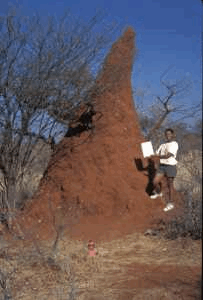
Termite mounds like pepper the landscape of Southern Africa (Photo: J. Scott Turner)
YOUNG: We usually think of termites as demolition experts, but apparently they are brilliant architects as well. J. Scott Turner, who teaches biology at the State University of New York at Syracuse, thinks that human builders have a lot to learn from termite mounds, especially the way they harness the wind. Living on Earth’s Steve Curwood spoke with Professor Turner about how these tiny insects build such green homes.
TURNER: Well, the secret of the termites is that they've learned how to exploit a kind of wind energy that most engineers and architects regard as a kind of nuisance. This kind of wind energy is turbulent wind energy. Every time you go out into a kind of windy environment and you hear the wind hissing past your ears, that’s turbulent wind energy and it’s the most common form of wind energy that’s out there, but for a long time wind engineers have kind of looked down upon.
CURWOOD: So, I understand part of your discovery and realization involves, well, almost music. Is there some sort of resonance in these mounds?
TURNER: Well, now if you open up one of these termite mounds, you see that there’s not just a single tube, there’s a network of tubes. But the remarkable thing about them is that they’re very, very long and they’re relatively straight, of course, they undulate around back and forth, but for the most part they’re vertically oriented.

Despite their small size these subterranean termites build some of the biggest structures in the animal kingdom. (Photo by Scott Bauer)
The way it works is that the superficial tunnels, they tend to resonate at fairly high frequencies, but as you go deeper and deeper into the mound and the nest, this network of tunnels actually helps to kind of tune out these higher frequencies and you get a kind of a different tone of vibration going on deep in the mound and this kind of tuning function that the mound engages in – this tuning of the messy energy and turbulent winds is crucial to these mounds ability to breathe and to help maintain the climate inside the nest.
CURWOOD: So, let me see if I have this right: what happens here is you have – the termite make a bunch of tubes, they’re kind of like musical instruments, like a bunch of clarinets or something, or maybe an organ, a pipe organ structure there – and the vibration of the sound, the vibration of the wind really helps move the air through for the ventilation. How does that work?
TURNER: Well, you have a number of different tubes just like in a pipe organ where you have one tube that corresponds to one note. If you connected all those tubes together you would get kind of a hissing sound that ranges from a fairly high-pitched hiss at the surface to a very low frequency, almost a sigh-like movement of air deep within the mound and nest. And these nests can get to be quite a stuffy affair, there’s a lot oxygen consumption and heat production down there, and in order for them to be able to tolerate that and live, they have to have someway of being able to ventilate that nest, and the mound is the way they do it.
CURWOOD: So, how applicable is this science to heating and cooling the buildings we’re in? Frankly, you know, we use a lot of energy heating and cooling.
TURNER: Well, this is the dilemma in modern architecture. You know, as you say, we build a building by creating a wall, you know, walling off a space from the outside and then we spend a great deal of energy and materials reconnecting that space to the outside. But what needs to be done is to actually rethink the whole concept of the wall. We normally think of the wall as an impermeable barrier, but in the case of termite mounds, their wall, if you will, the outside of the mound, is basically a tuned interface between the inside environment and the outside environment.

Termite mounds pepper the landscape of Souther Africa (Photo credit: Jay Scott Turner)
And the secret of being able to do this for all buildings is to be to reproduce the complex structure that enables termites to do this. So, our thinking is that if you can somehow replace impermeable walls with these kinds of structures that can actually tune the inconvenient energy that’s in turbulent wind, then you’re opening the door to, I think, a revolution to the way we think about wind technology. You can have not only ventilation for free in any building, but we’re working on designs that can enable the control of humidity, perhaps even wind-powered air conditioning in ordinary buildings. So, mainly by exploiting this untapped band of wind energy that’s out there.
CURWOOD: So, what’s the closest existing human habitat to a termite mound?
TURNER: Well, you find a lot of traditional architecture, what’s sometimes called vernacular architecture, and some of the most interesting examples of this are in North Africa. You see castles built from sand and clay, and they incorporate many of the same features that the termite mounds use. This kind of idea has actually been available in vernacular architecture for a long time. Back in the 1990’s though, mid-1990’s, one of the pioneering buildings in this was a building called the Eastgate Center, which was constructed in Harare, Zimbabwe by an architect named Mick Pearce.
And he had a very interesting philosophy, which is resonating quite strongly these days in, namely, if you build a building in an environment, especially a harsh environment like the tropics, you should look to inspiration to animals that live there and live there comfortably for the designs that you incorporate. And Mick Pearce did this in the Eastgate Center and his idea was so captivating that actually many architects are now looking into ways of using wind energy in imaginative ways to be able to accomplish what we now burn lots of fossil fuels to accomplish.
CURWOOD: Professor, one thing about this idea, though. Are people going to have to listen to music inside these tuned buildings? I mean, and if so, would you be able to get like one that plays the Beatles as opposed to Bach, or something?
TURNER: Playing the Beatles as opposed to Bach would be a tall order, definitely. But, the good news here is that you can actually implement these things at sounds frequencies actually below the range of human hearing, so at the most you may hear a nice gentle hiss or a sigh, but most of the work is going to be done at frequencies actually below the level at which you can hear.
YOUNG: That’s Professor J. Scott Turner talking with Living on Earth’s Steve Curwood.
Related link:
Read Professor J. Scott Turner's blog here
Branching into New Sounds

Diego bows twigs to create tonal sounds. (Photo: Diego Stocco)
YOUNG: We owe a lot of our music to wood: the bodies of guitars and violins, the keys of a marimba, drumsticks and, of course, those clarinets and other woodwinds. Sound designer Diego Stocco decided to go straight to the source and play a tree itself, for his project, aptly titled, “Music from a Tree.” All the sounds that you’ll hear come from an old olive tree behind his house in Burbank, California.
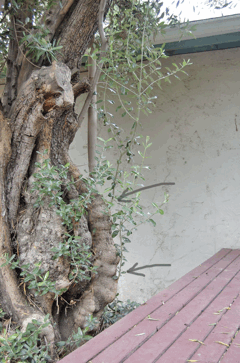
These two green twigs started to grow very fast after the recording of Music from a Tree. Diego wonders if playing music on the tree increases circulation and stimulates growth, "I don't know if it's a coincidence, but those are growing exactly from the branch I was hitting at the beginning of the video." (photo credit Diego Stocco)
STOCCO: We are in the backyard of my house and there is a tree. It’s a regular tree, nothing special, not one of the tree you see in the pictures, you know, that look all perfect – this one looks imperfect, but that’s probably the beauty of it; that’s why I was probably able to extract so many sounds. So, the beginning of this musical experiment was to create the rhythm first, and to create the rhythm I used a big branch by hitting against the cortex and leaves, so basically it’s like this:
[SHAKING BRANCHES; TAPPING SOUND ON TREE]
STOCCO: There is a sound that comes from the cortex when you pluck it.
[SOFT, HOLLOW SOUND]
STOCCO: I tuned it the twigs with a pencil sharpener, so the shorter the twig, the higher is the pitch of that note. And then I added the tonal sounds. So, I have in front of me, I don’t what, at least five different twigs. So, this is one.
[HIGH PITCH, SQUEAKY SOUND]
STOCCO: Then I have this here for the bass.

Diego bows twigs to create tonal sounds. (photo credit Diego Stocco)
[LOWER PITCH, VIOLIN-LIKE SOUND]
STOCCO: And I have another here, which is higher in pitch. I can also play them with two bows, but what I did was trying to organize those sounds into something more meaningful. I mean more musical, I don’t know if it’s more meaningful or not, but more musical.
[TREE AND TWIGS BEING PLAYED TOGETHER]
STOCCO: So this, it doesn’t really sound as a musical piece now, but…
[MORE SYNCHRONIZED, RHYTHMIC MUSIC]
STOCCO: Okay! I got it. That groove keeps going and then…
[BASS SOUNDS FROM TWIGS]
STOCCO: It might be just an idea, but I was thinking it would be really fantastic to play a forest, not just by myself – imagine like 30 people in the forest selecting different trees, selecting different sounds from those trees; creating a real piece of music not just hitting branches and stuff.
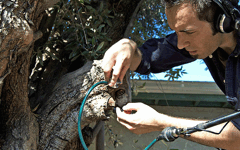
Diego uses stethoscopes-like microphone to amplify the tree. (photo credit Diego Stocco)
Definitely, you cannot bring the forest in the stadium, you know? [Laughs] Some people thought that I was, you know, kind of violent with the tree, but it’s not! It’s not! As an additional note, I would like to say that moving the tree is creating vibrations actually makes the circulation better, so the tree is enjoying people making music with it.
[MUSIC STOPS]
STOCCO: And, uh, that’s the idea basically behind music from a tree.
YOUNG: Living on Earth’s Ike Sriskandarajah whittled our audio portrait of Diego Stocco and his musical tree – there are pictures at our website, LOE dot org.
Related links:
- Hear more of Diego's compositions
- Watch the original music video from Music From a Tree
[MUSIC: Music provided by Diego Stocco, recorded on location.]
YOUNG: Living on Earth is produced by the World Media Foundation. Our crew includes Bobby Bascomb, Eileen Bolinsky, Bruce Gellerman, Ingrid Lobet, Helen Palmer, Jessie Martin, Jessica Ilyse Smith, Ike Sriskandarajah, and Mitra Taj, with help from Sarah Calkins, Marilyn Govoni, and Sammy Souza.
YOUNG: Our interns are Quincy Campbell and Nirja Parekh. Jeff Turton is our technical director. Alison Lirish Dean composed our themes. You can find us anytime at LOE dot ORG. Steve Curwood is our executive producer. I'm Jeff Young. Thanks for listening.
ANNOUNCER: Funding for Living On Earth comes from the National Science Foundation supporting coverage of emerging science. And Stonyfield farm, organic yogurt and smoothies. Stonyfield pays its farmers not to use artificial growth hormones on their cows. Details at Stonyfield dot com. Support also comes from you, our listeners. The Ford Foundation, The Town Creek Foundation, and The Oak Foundation, supporting coverage of climate change and marine issues. The Skoll Foundation, supporting social entrepreneurs around the world. Uncommon heroes dedicated to the common good. Learn more at scole dot org. And Pax World Mutual Funds, socially and environmentally sustainable investing. Pax world for tomorrow. On the web at pax world dot com.
ANNOUNCER 2: PRI – Public Radio International.
Living on Earth wants to hear from you!
Living on Earth
62 Calef Highway, Suite 212
Lee, NH 03861
Telephone: 617-287-4121
E-mail: comments@loe.org
Newsletter [Click here]
Donate to Living on Earth!
Living on Earth is an independent media program and relies entirely on contributions from listeners and institutions supporting public service. Please donate now to preserve an independent environmental voice.
NewsletterLiving on Earth offers a weekly delivery of the show's rundown to your mailbox. Sign up for our newsletter today!
 Sailors For The Sea: Be the change you want to sea.
Sailors For The Sea: Be the change you want to sea.
 The Grantham Foundation for the Protection of the Environment: Committed to protecting and improving the health of the global environment.
The Grantham Foundation for the Protection of the Environment: Committed to protecting and improving the health of the global environment.
 Contribute to Living on Earth and receive, as our gift to you, an archival print of one of Mark Seth Lender's extraordinary wildlife photographs. Follow the link to see Mark's current collection of photographs.
Contribute to Living on Earth and receive, as our gift to you, an archival print of one of Mark Seth Lender's extraordinary wildlife photographs. Follow the link to see Mark's current collection of photographs.
 Buy a signed copy of Mark Seth Lender's book Smeagull the Seagull & support Living on Earth
Buy a signed copy of Mark Seth Lender's book Smeagull the Seagull & support Living on Earth

